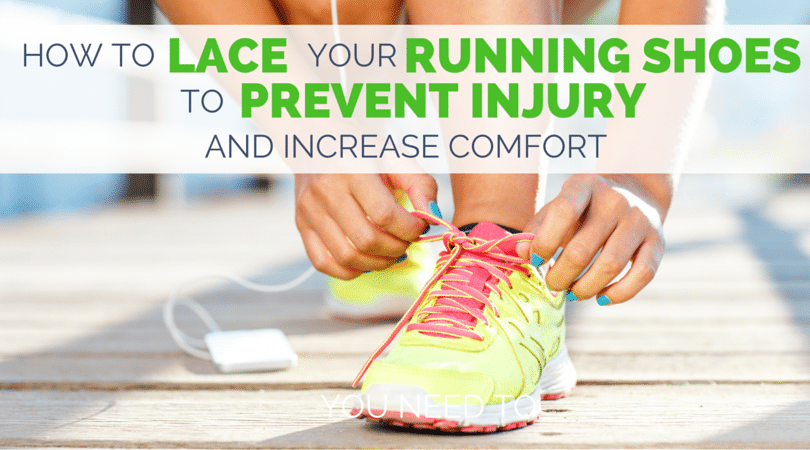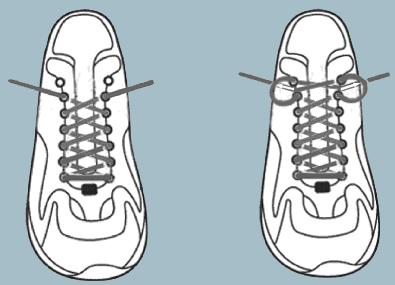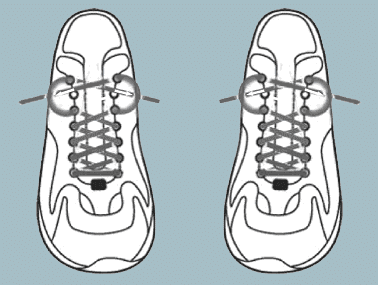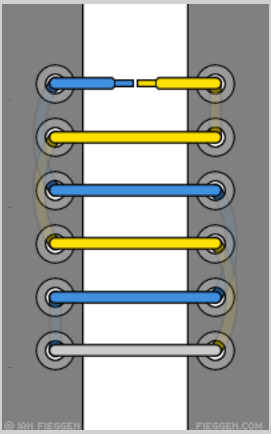Running is pretty simple. One foot in front of the other, and all we really need are good running shoes, but you need to know how to lace up running shoes if they are to help you the most, especially if you have high arches or shin splints.
Injury risk is higher if you do not use the best way to lace up running shoes, which we are going to show you today. If you have wondered what that top hole on your running shoes is for, we will show you and make sure that you feel comfortable regardless of whether you have a wide forefoot or narrow foot.
Now:
Most biomechanics and physiology researchers focus their efforts on big topics like injury, performance, and health.
And rightly so.
We as runners are famous for ignoring preventative help until an injury creeps up, then suddenly we are paying attention.
Don’t worry, its a common trait we all share.
Most of the research papers are usually centered on fundamental issues like foot strike, pronation, and breathing while running.
But, fortunately for us, a few researchers take the time to investigate some of the lesser but still important topics.
For example, a while back, we looked at some scientific studies on chafing and blistering in runners—something that many of us suffer from…especially if we are not lacing up our shoes correctly!

Is There a Best Way to Lace Running Shoes?
One particular research group, headed by Marco Hagen at the University of Duisberg in Germany, has published several papers on just that question.
The first of these papers, published in 2008, looked at the biomechanics of twenty distance runners moving at 8:00 mile pace on a treadmill under a variety of different lacing conditions.
Data on impact force, pronation, and the pressure under the sole of the foot were collected.
All runners wore the same shoe, a Nike Air Pegasus, but laced several different ways.
As do most running shoes, the Pegasus has six eyelets on each side, plus a seventh at the top which is slightly offset from the rest.
Here’s where it gets interesting:
The first three lacing conditions involved tying the shoes (with the normal 6-eyelet cross lacing) with different tightnesses, “weak,” “normal,” and “tight,” as perceived by the subjects in the study.
After that, the researchers tested some additional lacing patterns, including an incredibly lose two-eyelet lacing (using only the first and second eyelets, a three-eyelet lacing (using the first, third, and fifth), and a seven-eyelet lacing using a “heel lock” loop on the final shoe eyelet, as depicted below.

Anyone want to guess what they found?
Normal lacing vs seven-eyelet heel lock lacing
The results showed that shoes tied tightly reduce pronation velocity and, more importantly, reduced impact loading rates.
Now:
As you might have guessed, the looser and less comprehensive lacings using only two or three eyelets resulted in increased impact loading rates and pronation velocities.
Pronation has not been reliably tied to injury rates, but impact loading rates have, so a reduction in loading rate by simply tightening your shoes is noteworthy.
A tight lacing also reduced localized pressure on the outside of the foot, likely by pulling the heel deeper into the shoe’s insole.
But did you expect this?
There was a downside—the runners consistently reported the tight-laced condition as being one of the least comfortable.
However, Hagen et al. found that the seven-eyelet “heel lock” lacing at a normal tightness was just as effective at reducing impact loading rates, pronation velocity, and plantar foot pressure as the standard six-eyelet lacing tied tightly.
It get’s better:
In a later study, Hagen and his colleagues conducted a similar experiment, however, this time they added a measurement of the pressure on the top of the foot.
This is an important step forward, as increasing the tightness of your laces increases pressure over the top of the foot, including the navicular bone and the extensor tendons that cross the ankle.
While these areas are not injured very often, injuries to the navicular and extensor tendons can be very bothersome.
None of us want a stress fracture in one of those high risk areas!
Using a similar experimental procedure, Hagen et al. tested fourteen male runners using only the normal six-eyelet lacing, the seven-eyelet heel lock, and a variant of the heel lock in which the sixth eyelet is skipped.
The results showed that the two lacings that utilize the seventh eyelet result in lower pressures on the top of the foot without sacrificing any significant amount of stability in the foot’s contact with the insole of the shoe.
Check this out:
The special heel lock which skips the sixth eyelet (pictured below) was particularly effective at reducing pressure on the top of the foot.

Seven-eyelet heel lock lacing and special heel lock lacing which skips the sixth eyelet.
One lacing style I was disappointed that Hagen did not investigate is “ladder lacing” (sometimes called “Lydiard lacing” after Arthur Lydiard, who advocated its use in some of his books in the ‘60s and ‘70s).
Ladder lacing is a technique which (purportedly) reduces pressure on the top of the foot by not allowing the laces to cross over the middle of the metatarsals.
I would be interested to see whether this preserves shoe stability while reducing pressure on the top of the foot.

Additionally, many shoes today come with straps instead of eyelet holes.
It’s unclear whether these provide any additional stability or advantages compared with regular eyelets. As always, there’s more research to be done!
Which is the Best Way to Lace Up My Running Shoes?
For the average runner, Hagen’s work highlights the importance of lacing up your shoes snugly.
Most runners would probably be well-served by using a heel-lock lacing to increase the stability of their shoe and decrease their impact loading rates.
If you are prone to injury on the top of your foot, or if you find tight or high lacing uncomfortable, try using the special heel lock, as it has all the benefits of the regular heel lock or tight normal lacing, but with less pressure on the top of the foot.
And lastly, don’t forget to double-knot your shoes!
RunnersConnect Bonus
Download your FREE lacing techniques guide.
You know how to read the wear of shoes, but are you lacing your shoes wrong? Download our Running Shoe Lacing guide for free and get a quick reminder, specific how-to and resources for videos on the best way to lace your running shoes.




14 Responses
I would recommend visiting a running store and having an employee look at your feet to give you a good idea of what category your feet fit in. If you have serious foot complications like extreme pronation, fallen arches, etc I would recommend visiting a foot doctor, as running shoes by themselves might not be enough. You could require orthotics, or even just simple strengthening exercises to get and keep you on your feet.-
Is it just my perception or are the different lacing photos actually the same? I want to see the special heel lock lacing that skips the 6th, but think it’s not shown. Thanks.
Thanks for the heads up. Image fixed!
I have switched to a ladder lacing with a heel lock in the final eyelets and love it! I have always used the heel lock but before i started using the ladder lacing I was always have heel and arch pain that mimicked PF but never exhibited the classic PF symptoms (pain the morning, after sitting, etc). Since switching to ladder lacing that has completely disappeared. I have also noticed that my lower legs are not nearly as fatigued after my long runs since switching. One caveat to ladder lacing that I have noticed though is that my laces tend to come un-tied more easily. Not sure why. I just have to double knot.
I just read your comment and it sounds like my problem. After longer runs my arch and my heel hurt. They said it seems like PF, but I don’t have the other symptoms. Can you tell me where you got the information on how to do the ladder lacing with the heel lock? I am training for my first half marathon and I’m doing a long run (long for me) tomorrow and I’d like to try it.
Thank you!
Hi Sari, not sure what you are looking for with the lacing. Is there a reason you cannot try your laces the way we recommended in the post? Just want to get an idea for what you are looking for 🙂
I have severe PF, limited my exercise down to walking 3 miles a day. I am out of options. I wear Brooks and have custom orthotics. No relief. I notice my shoes are lose, should I use the ladder method and tighten them tight? Any suggestions would be appreciated. Mri today confirmed acute PF with swollen kager fat pad and lateral metatarsal swelling with fluid, from inflation.
Hi Shelley, sorry to hear about your PF. Have you read our article on how to recover from it? https://runnersconnect.net/running-injury-prevention/plantar-fasciitis-in-runners/ This should provide you lots of different ways of attacking it to get back on track. Would probably best to take some time off if your doctor recommended it based on your MRI findings. Unfortunately this is all we can recommend for now! Hope it heals up quickly.
Interesting study. I’m a runner and also a basketball player. I stumbled on this article while trying to find a heel lock system for some new Adidas basketball shoes I bought online. I haven’t bought Adidas in forever because I always experience heel slippage. The new pair is, unfortunately, no different. (I thought I’d give Adidas another shot after 12 years because the price was right) The heel lock system described in this article totally works though. I’m a bit amazed at how well it works actually and am now going to try it on some New Balance trail runners I recently picked up for the fall/winter runs. Thanks again for the article.
Hi Jeffrey, thanks for reaching out and sharing your feedback. We are glad to hear that it works for you, and we hope you continue to use us as a source for your running related questions! Best of luck with your future!
Hi, great article, I have the Pegasus 31’s, which eyelet is considered the 6th?
Hi Greg, it would be the hole that is furthest away from your toes, they do not usually fall on a line with the rest, but slightly closer to your ankle. Hope this helps!
Nice blog. Thank you for your valuable information.
The blog and the post are absolutely fantastic! A lot of information is helpful in some way. Keep updating the blog, looking forward to more content …Great job, keep it up.
Thank you very much, David!